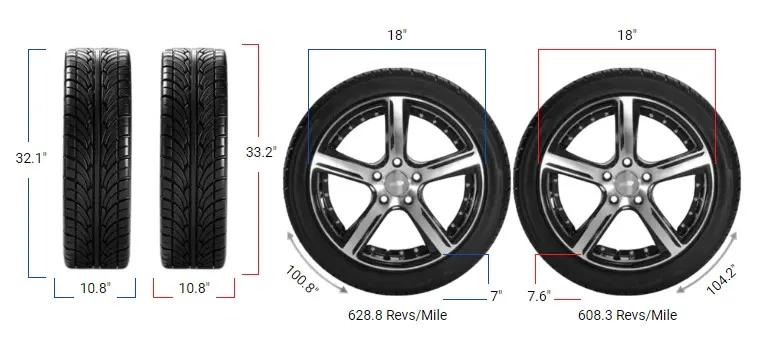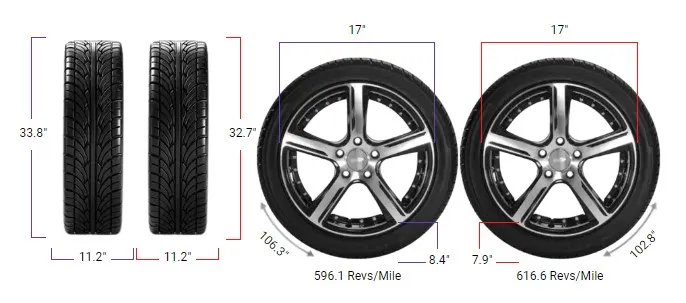Tire Size 245/45r18 vs 235/50r18

Ever thought about changing your tire size? Switching from a 245/45r18 to a 235/50r18 might seem simple, but let’s dive into what that really means for your vehicle.
- The 235/50R18 offers a slightly larger diameter for improved ground clearance.
- Switching may result in better ride comfort due to a taller sidewall.
- The narrower width of the 235 tire can enhance fuel efficiency.
- The 235 tire may provide better handling in certain conditions.
- There could be a slight decrease in traction with the narrower tire.
- The 245 tire can offer more stability during high-speed maneuvers.
- The 235 tire may reduce road noise for a quieter ride.

Fitment Guide
According to fitment guidelines, if the diameter difference between tire sizes exceeds 3%, swapping them is not recommended.
In this case, the difference is 2.1%, so it’s within the acceptable range for a safe interchange.
On-Road Impact
Switching tire sizes can affect your driving experience on city streets and highways. Let’s see how this change impacts your daily commute.
Ground Clearance
The slightly larger diameter of the 235/50r18 tires increases the vehicle’s ground clearance by approximately 0.29 inches.
While this isn’t a significant change, it can help when navigating over speed bumps or uneven road surfaces.
For most city drivers, this difference is minimal and won’t dramatically alter the driving experience.

Gas Mileage
A change in tire diameter can influence your car’s gearing, which in turn affects fuel efficiency. The engine may have to exert slightly more effort to turn the larger tires, potentially leading to a minor decrease in gas mileage.
However, this difference is typically small—often less than a 1% change—and may not be noticeable in daily driving.
Aesthetic Look
The change in tire size can subtly alter your vehicle’s appearance. The taller sidewalls of the 235/50r18 tires give the car a more robust look.
Some drivers find this enhanced profile more visually appealing. However, aesthetic preferences are subjective, so this benefit varies from person to person.
Ride Comfort
One of the more noticeable changes is in ride comfort. The increased sidewall height (an extra 0.29 inches) allows the tire to absorb more of the bumps and potholes common on city streets.
This can result in a smoother, more comfortable ride, reducing driver fatigue over long distances.

Speedometer Accuracy
The 2.1% increase in tire diameter means that your speedometer will read slightly slower than your actual speed.
For example, when your speedometer shows 60 mph, you’re actually traveling at about 61.26 mph.
While this difference is small, it’s important to be aware of it to avoid unintentionally exceeding speed limits.
Handling & Performance
The narrower width of the 235/50r18 tires (a decrease of 0.39 inches) can affect the tire’s contact patch with the road. This may lead to slightly reduced grip during cornering and braking.
For everyday driving, this difference is usually negligible, but performance-oriented drivers might notice a slight change in handling.
Durability & Wear
Tire wear can be influenced by changes in size. The taller sidewall may lead to more even tire wear over time due to better shock absorption.
However, the reduced width could concentrate wear over a smaller area. Regular tire rotations and proper inflation can mitigate these effects.
Off-Road Impact
For those who enjoy venturing off the pavement, changing tire sizes can impact your vehicle’s off-road capabilities. Let’s delve into how this switch affects off-road performance.
Ground Clearance
The increased diameter of the 235/50r18 tires raises the vehicle slightly, providing an extra 0.29 inches of ground clearance.
While modest, this can help clear small obstacles like rocks or roots, offering a slight advantage when tackling rough terrain.
Traction
Off-road traction can be affected by tire width and sidewall height. The narrower 235 width may improve traction in certain conditions, such as muddy or snowy terrain, where a narrower tire can cut through to firmer ground. However, in sandy conditions, wider tires often perform better.
Ride Comfort
The taller sidewall of the 235/50r18 tires acts like a cushion, absorbing shocks from bumps and dips more effectively than the lower profile 245/45r18 tires.
This can make off-road excursions more comfortable, reducing the jarring impact of uneven surfaces.
Durability & Wear
Off-road driving puts additional stress on tires. The increased sidewall height can provide better protection against punctures and cuts from sharp rocks or debris.
However, the narrower tire may be more susceptible to sidewall damage if the vehicle’s weight is not properly supported.
Handling and Stability
The slight increase in tire diameter can affect the vehicle’s center of gravity, although the change is minimal.
The narrower width may result in a smaller contact patch, potentially reducing stability on uneven surfaces. This effect is generally minor but could be noticeable in more extreme off-road conditions.
245/45r18 vs 235/50r18
This table compares the key features of tire sizes 245/45R18 and 235/50R18.
| Feature | 245/45R18 | 235/50R18 | Difference |
|---|---|---|---|
| Diameter inches (mm) | 26.68 (677.7) | 27.25 (692.2) | 0.57 (14.5) 2.1% |
| Width inches (mm) | 9.65 (245) | 9.25 (235) | -0.39 (-10) -4.1% |
| Circumference inches (mm) | 83.82 (2129.06) | 85.61 (2174.61) | 1.79 (45.55) 2.1% |
| Sidewall Height inches (mm) | 4.34 (110.25) | 4.63 (117.5) | 0.29 (7.25) 6.6% |
| Revolutions per mile (km) | 755.9 (469.69) | 740.06 (459.85) | -15.83 (-9.84) -2.1% |
| Speedo Reading | 20 mph (32.19 km/h) | 20.43 mph (32.88 km/h) | +0.43 mph |
Difference Between 245/45R18 and 235/50R18
The 245/45R18 tire is 0.57 inches smaller in diameter, 0.39 inches wider, and has a 2.1% smaller circumference compared to the 235/50R18 tire.
Can I Use 235/50R18 Instead of 245/45R18?
Yes, you can use a 235/50R18 tire instead of a 245/45R18. However, the difference in size may affect your speedometer and handling slightly due to the difference in width and diameter.
How Much Taller Is a 235/50R18 Tire Than a 245/45R18?
The 235/50R18 tire is approximately 0.57 inches taller than the 245/45R18 tire, with a diameter difference of 2.1%.
How Much Wider is a 245/45R18 Tire Than a 235/50R18?
The 245/45R18 tire is 0.39 inches wider than the 235/50R18 tire, with a width difference of 10 millimeters.
Our Observation
Switching from 245/45r18 to 235/50r18 tires offers both advantages and disadvantages.
On the plus side, the increased sidewall height enhances ride comfort and provides a slight boost in ground clearance, benefiting both on-road and off-road driving.
The change is within the acceptable diameter difference, so fitment should not be an issue. However, the narrower width could lead to minor reductions in traction and handling, especially in high-performance or challenging driving conditions.
The impact on fuel efficiency and speedometer accuracy is minimal and may not be significant for most drivers.
Ultimately, the switch can be a good choice for those seeking improved comfort and a subtle aesthetic change, with the understanding that performance characteristics may be slightly altered.



